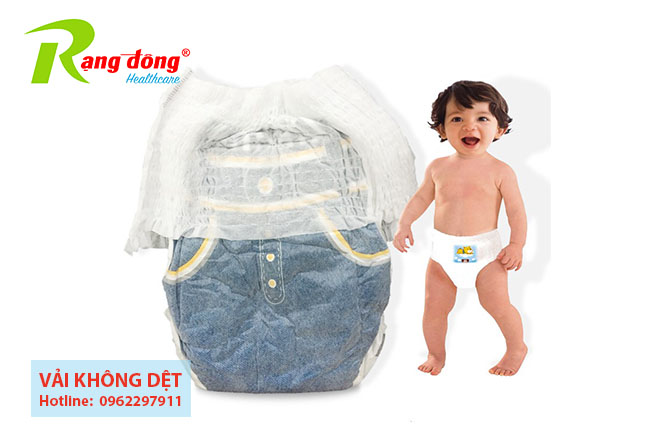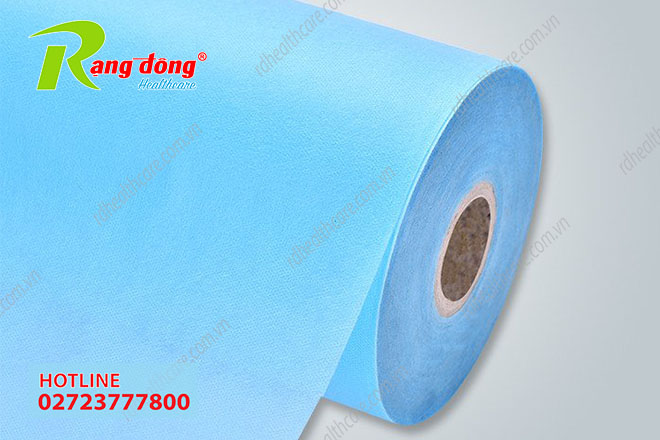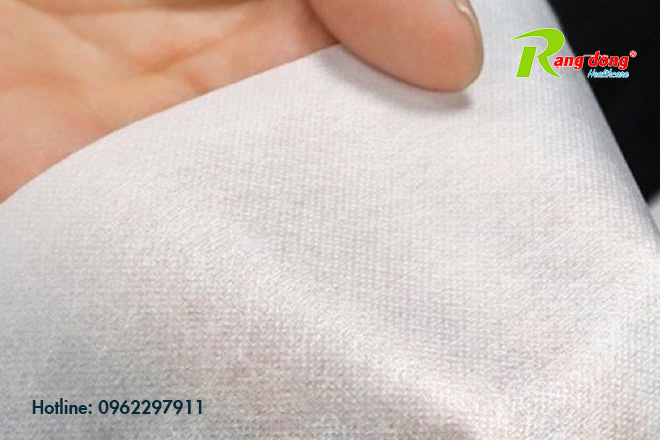Non-woven fabric and its applications in the production of personal hygiene products Product information 27/04/2023
With the criterion “for the health of the community as a foundation,” the products are manufactured according to US standards, marking an important step for the medical industry in Vietnam. Rang Dong Healthcare Joint Stock Company has introduced non-woven fabric products, including daily personal hygiene products such as tissue paper and sanitary napkins.

Non-woven fabric for medical masks
Non-woven fabric is different from traditional woven fabric, as it is created by bonding, pressing, connecting, or stacking fabric fibers together without the need for weaving techniques.
The characteristics of non-woven fabric include high durability, water resistance, resistance to wear and tear, and good resistance to expansion and contraction, while thickness and hardness can be adjusted as needed.
Personal hygiene products include daily-use items such as sanitary napkins, diaper liners, tissue paper, wet wipes, and decorative patches. These products have become an indispensable part of modern life and are widely used worldwide.

Non-woven fabric for baby diaper liners
Non-woven fabric has played a crucial role in the production of personal hygiene products, helping to create products with high durability, excellent absorbency, and good water resistance, ensuring comfort and safety for users.
Advantages of non-woven fabric in the production of personal hygiene products
Excellent absorbency: Non-woven fabric is widely used in the production of paper diapers, sanitary napkins, and tissue paper due to its excellent absorbency and moisture retention properties.
High durability and flexibility: It is strong and flexible, making it resistant to tearing or stretching.
Environmentally friendly: It is produced from recycled materials and can be recycled after use. Additionally, it does not contain harmful substances such as PVC or latex.
Easy to manufacture and use: It can be manufactured in various sizes, thicknesses, and hardness levels to meet different product requirements. It is also easy to cut, package, and use in the production of personal hygiene products.
Adaptability: It is used in various products, from personal hygiene products to medical products, household items, and packaging.
Personal hygiene products made from non-woven fabric
Non-woven fabric is lightweight, soft, and highly absorbent, making it widely used in the production of personal hygiene products. Some personal hygiene products made from non-woven fabric include tissue paper, sanitary napkins, diaper liners, facial wipes, protective underwear pads, non-woven fabric bags for women’s hygiene products, bath towels, wet wipes, dry tissue paper, and shoe bags.

Antibacterial non-woven medical fabric
Production technology of personal hygiene products from non-woven fabric
Raw materials for non-woven fabric production
Raw materials for non-woven fabric production include natural fibers such as cotton, wool, flax, silk, jute, grass, etc., or synthetic fibers such as polyester, nylon, PP, PE, etc.
The technology of non-woven fabric production includes the following steps:
- Preparation of raw materials: Fibers are processed and mixed to create a uniform mixture.
- Fiber bonding: Fibers are bonded together using chemical or mechanical bonding, heat, or pressure.
- Compression and cutting: The fabric is compressed to create the desired thickness and strength. The fabric is then cut into various sheets of different sizes and shapes for various applications.
- Finishing the product: Final processing steps such as cutting, weaving, and packaging are done before the product is introduced to the market.
The technology of non-woven fabric production is widely used in various industries, such as lining materials, filtration, packaging, textiles, medical, and agriculture.
Production processes of personal hygiene products from non-woven fabric
Personal hygiene products made from non-woven fabric can be produced through the following main steps:
- Raw materials: Select suitable non-woven fabric materials for the specific type of product to be manufactured.
- Fabric cutting: Use cutting machines to cut the fabric into the appropriate size and shape for the product.
- Fabric processing: Non-woven fabric needs to be processed to enhance absorbency or antibacterial properties if necessary.
- Production: Use machinery and equipment to produce the product, such as heat presses, printers, packaging machines, cutting machines, etc.
- Quality control: Inspect the product after production to ensure quality and compliance with safety regulations.
- Packaging: Package the product to protect and preserve it until it is used.
- Transportation: Transport the product to retail points or storage facilities before reaching the end users.
Technical and quality requirements for the production of personal hygiene products from non-woven fabric
Personal hygiene products made from non-woven fabric have various technical and quality requirements, depending on the specific product type.
- Softness and durability: Ensure softness and superior durability for extended use.
- Absorbency: Excellent absorbency to keep users dry and comfortable.
- Health safety: Ensure the safety of users, with no harmful or allergenic substances.
- Hygiene standards: Adhere to strict hygiene standards to ensure safety and reliability.
- Aesthetics: High aesthetics to attract users.
Furthermore, personal hygiene products made from non-woven fabric must comply with the regulations and standards of relevant authorities to ensure product safety and reliability.
The market for personal hygiene products made from non-woven fabric
The market for personal hygiene products made from non-woven fabric is growing rapidly and becoming one of the potential sectors in the non-woven fabric manufacturing industry.
These products include items such as diaper liners, tissue paper, diapers, and more. They are made from non-woven fabrics with antibacterial, absorbent, and breathable properties, providing comfort and cleanliness for users.

This market is growing rapidly due to the benefits of these products, including reduced environmental impact, cost savings, and the prevention of skin-related conditions and infections.
Non-woven fabric is a versatile and convenient material in the production of personal hygiene products, with many advantages and useful applications.
Opportunities and potential for the development of personal hygiene products from non-woven fabric
- Absorbent and breathable properties: Excellent absorbency to keep the product dry and breathable.
- Antibacterial properties: Natural antibacterial properties to keep personal hygiene products clean and prevent the spread of bacteria.
- Water resistance: Produce personal hygiene products with water resistance to prevent leakage.
- Ease of production and recycling: Rapid production and recyclability, minimizing environmental impact.






